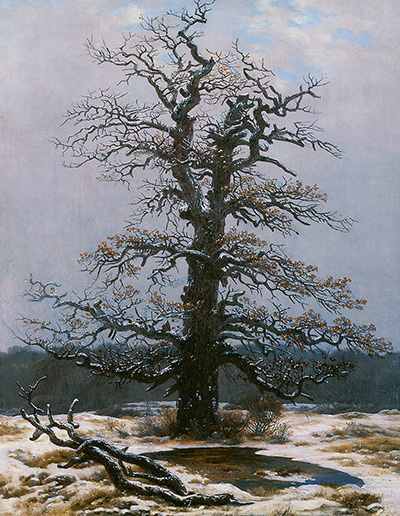Oak Tree in the Snow is a marvellous artwork done by the famous German Romantic landscape creator and can be dated back to 1829, and its original title was Eiche im Schnee. His paintings were well distinguished as he brought out early morning mists, silhouettes, and lifeless trees in a way that no one else could do it.
This particular creation was no exception. At first glance, you’ll see an almost leafless brutally chopped up an oak tree in the foreground surrounded with small patches of brown grass popping up from the expansive winter snow. As you slowly move towards the middle ground, and with a keen eye, you’ll notice icy waters. Right after that, there seems to be a dense forest. The background is mainly made up of blue skies scattered in clouds. The current location of the painting is Wallraf-Richartz Museum, and where the art is believed to have been done is in his studio in Dresden on the Elbe.
In this painting, Friedrich was clearly fascinated by the seasons, naturalism, and the passing of time. This is evident from how he seamlessly blended the weather cycles in one painting. His clear depiction of the snow and the almost barren tree with small leaves symbolise the assurance of budding times ahead. This painting is done late in Friedrich’s life contained a lot of clues of recollection. The oak tree itself symbolizes brute strength and resilience and even still has been cut to pieces reminding us of the tough times the creator grew up in Germany. Yet again, the tree still manages to bear leaves, indicating the resilience of the German people. The blue sky finishes this off, showing better and brighter days ahead.
The landscape creation measured 71 cm (27.9") in height and 48 cm (18.8") in width and was done using oil on canvas. This was a technique that involved using oils that would dry up like walnut oil as a binding agent onto the canvas. Different oils determined the drying period, the sheen of the painting, and sometimes even the yellowing. Friedrich had to plan the picture by first sketching his ideas on canvas using very light paint or charcoal bits. When painting he had to ensure that he painted more oil on the layer above than the one below to allow for proper drying.
It is also vital to note that the painting was done in the Romantic era that laid massive emphasis on raw and intense emotions like horror, together with focusing on nature and the past. Artists believed in bringing out medieval times as that it was what they believed in as they fought off the industrial revolution. Famous works done by Friedrich include the Wanderer above the sea of fog. This masterpiece shows a man standing on a rocky landscape while holding a walking stick in a cloud of mist. It is considered one of the greatest works in the romanticism era. He inspired numerous people including the historian John Lewis terming him as one of the few artists that would leave a painting for your own interpretation.




